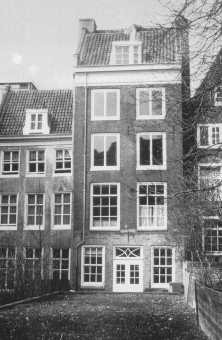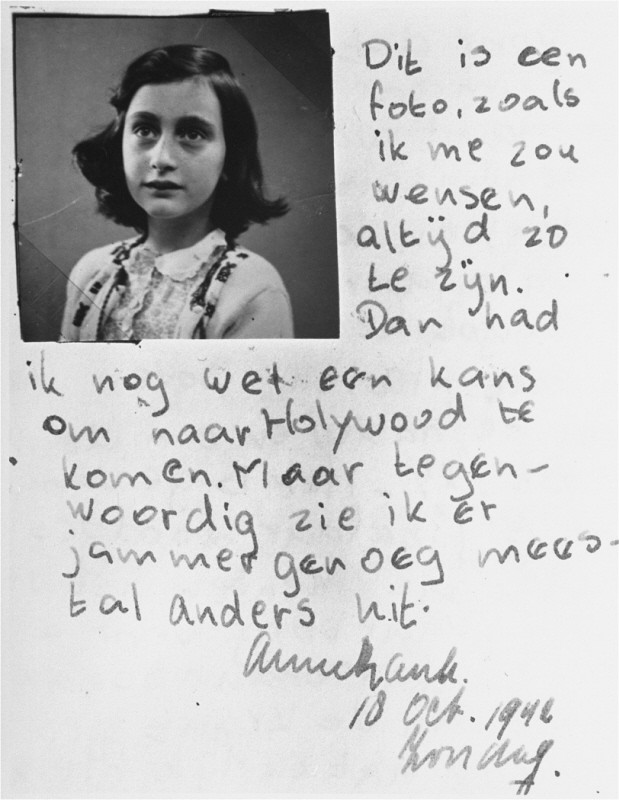
Anne Frank: Diary
The Diary of Anne Frank is the first, and sometimes only, exposure many people have to the history of the Holocaust. Meticulously handwritten during her two years in hiding, Anne's diary remains one of the most widely read works of nonfiction in the world. Anne has become a symbol for the lost promise of the more than one million Jewish children who died in the Holocaust.
Key Facts
-
1
There are several versions of her diary. Anne herself edited one version of the diary, in hopes of it being published as a book after the war.
-
2
The Diary of Anne Frank was published posthumously in 1947 and eventually translated into almost 70 languages.
-
3
It became popular after it was adapted for the stage in 1955.
The Diary Begins

Anne Frank and her family fled Germany after the Nazis seized power in 1933 and resettled in the Netherlands, where her father, Otto, had business connections. The Germans occupied Amsterdam in May 1940, and two years later German authorities with help from their Dutch collaborators began rounding up Jews and ultimately deported them to killing centers.
In July 1942, Anne, her sister, Margot, her mother, Edith, and her father went into hiding. They huddled into a secret attic apartment behind the office of the family-owned business at 263 Prinsengracht Street, which would eventually hide four Dutch Jews as well.
While in hiding, Anne kept a diary in which she recorded her fears, hopes, and experiences. She received her first diary on her 13th birthday, June 12, 1942. She wrote:
I hope I shall be able to confide in you completely, as I have never been able to do in anyone before, and I hope that you will be a great support and comfort to me.
I expect you will be interested to hear what it feels like to hide; well, all I can say is that I don't know myself yet. I don't think I shall ever feel really at home in this house but that does not mean that I loathe it here, it is more like being on vacation in a very peculiar boardinghouse. Rather a mad way of looking at being in hiding perhaps but that is how it strikes me.
[July 11, 1942]
The fact that we can never go outside bothers me more than I can say, and then I'm really afraid that we'll be discovered and shot, not a very nice prospect, needless to say.
[July 11, 1942]

Anne also wrote short stories, fairy tales, and essays. In her diary, she reflected on her "pen children," as she called her writings. On September 2, 1943, she began to meticulously copy them into a notebook and added a table of contents so that it would resemble a published book. She gave it the title "Stories and Events from the Annex." Occasionally she read a story to the inhabitants of the annex, and she wrote about her intention to send one of her fairy tales to a Dutch magazine. Increasingly, she expressed her desire to be an author or journalist.
On March 28, 1944, a radio broadcast from the Dutch government-in-exile in London urged the Dutch people to keep diaries, letters, and other items that would document life under German occupation. Prompted by this announcement, Anne began to edit her diary, hoping to publish it after the war under the title "The Secret Annex." From May 20 until her arrest on August 4, 1944, she transferred nearly two-thirds of her diary from her original notebooks to loose pages, making various revisions in the process.
Just imagine how interesting it would be if I were to publish a romance of the "Secret Annex." The title alone would be enough to make people think it was a detective story. But, seriously, it would be quite funny 10 years after the war if we Jews were to tell how we lived and what we ate and talked about here. Although I tell you a lot, still, even so, you only know very little of our lives.
[March 29, 1944]
On April 17, 1944, Anne began writing in what turned out to be her final diary notebook. On the first page she wrote about herself: "The owner's maxim: Zest is what man needs!" A few months later, she and the other inhabitants of the annex celebrated the Allied invasion of France, which took place on June 6, 1944. They were certain the war would soon be over.
In one of her last diary entries, dated July 15, 1944, Anne wrote:
I simply can't build up my hopes on a foundation consisting of confusion, misery and death, I see the world gradually being turned into a wilderness, I hear the ever approaching thunder, which will destroy us too, I can feel the sufferings of millions and yet, if I look up into the heavens, I think that it will all come right, that this cruelty too will end, and that peace and tranquility will return again. In the meantime, I must uphold my ideals, for perhaps the time will come when I shall be able to carry them out.
yours, Anne M. Frank.
On August 4, 1944, Anne, her family, and the others in hiding were arrested by German and Dutch police officials. Her last entry was written on August 1, 1944.
The Diary Survives
The Franks and the four others hiding with them were discovered by the German SS and police on August 4, 1944. A German official and two Dutch police collaborators arrested the Franks the same day. They were soon sent to the Westerbork transit camp and then to concentration camps.
Anne's mother Edith Frank died in Auschwitz in January 1945. Anne and her sister Margot both died of typhus at the Bergen-Belsen concentration camp in February or March 1945. Their father, Otto, survived the war after Soviet forces liberated Auschwitz on January 27, 1945.
Otto Frank later described what it was like when the Nazis entered the annex in which he had been hiding. He said an SS man picked up a portfolio and asked whether there were any jewels in it. When Otto Frank said it only contained papers, the SS man threw the papers (and Anne Frank’s diary) on the floor, walking away with silverware and a candlestick in his briefcase. “If he had taken the diary with him,” Otto Frank recalled, “no one would ever have heard of my daughter.”
Miep Gies, one of the Dutch citizens who hid the Franks during the Holocaust, kept Anne Frank’s writings, including her diary. She handed the papers to Otto Frank on the day he learned of his daughters’ deaths. He organized the papers and worked doggedly to get the diary published, first in Dutch in 1947. The first American edition appeared in 1952.
The Diary of Anne Frank did not become a best-seller until after it was adapted for the stage, premiering in 1955 and winning a Pulitzer Prize the next year. The book remains immensely popular, having been translated into more than 70 languages and having sold more than 30 million copies.
There are three versions of the diary. The first is the diary as Anne originally wrote it from June 1942 to August 1944. Anne hoped to publish a book based on her entries, especially after a Dutch official announced in 1944 that he planned to collect eyewitness accounts of the German occupation. She then began editing her work, leaving out certain passages. That became the second version. Her father created a third version with his own edits as he sought to get the diary published after the war.
The third version is the most popularly known. Not all of the versions include Anne’s criticism of her mother or the references to her developing curiosity about sex -- the latter of which would have been especially controversial in 1947.
The home where the Franks hid in Amsterdam also continues to attract a large audience. Now known as the Anne Frank House, it drew more than 1.2 million visitors in 2017.
New Educational Resource
Diaries as Historical Sources Lesson
Students study examples of diaries written by young people during the Holocaust, particularly examining the ways in which Anne Frank, the most famous diarist of the Holocaust, thought about her audience while writing. By analyzing these diaries as sources, students are encouraged to think of themselves as historical actors and to consider how they are documenting their experiences for future historians.
Critical Thinking Questions
Find diaries of other children impacted by the Holocaust. Compare and contrast their stories with Anne and Margot’s.
Learn about the network of individuals who tried to shield the Franks from arrest. What pressures and motivations may have affected them?
What can be learned from the choices of those who supported the Frank family in hiding?

